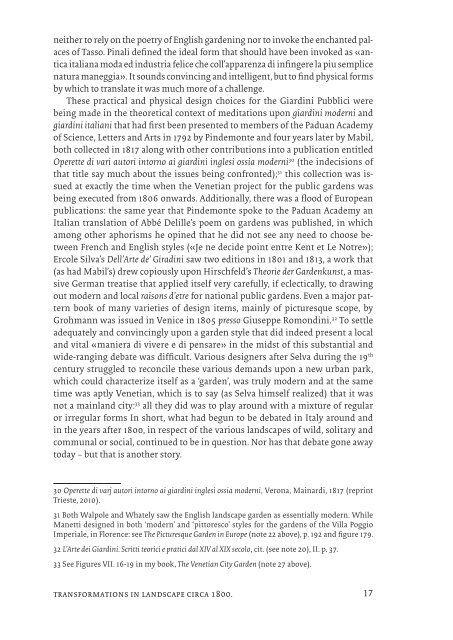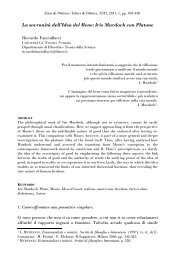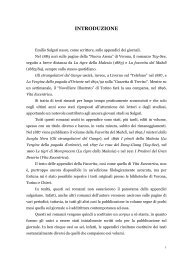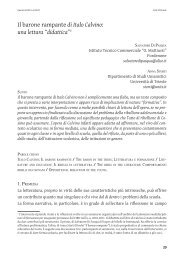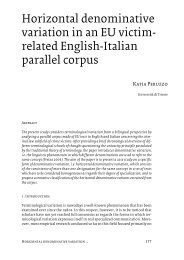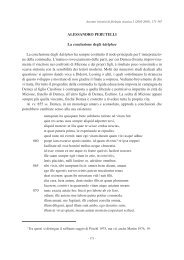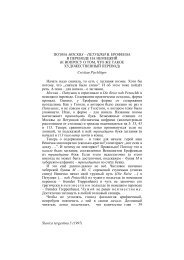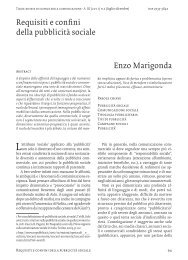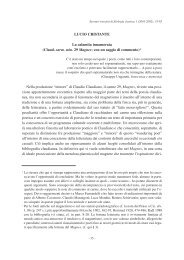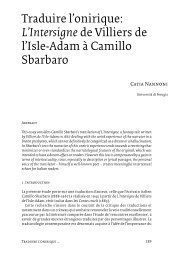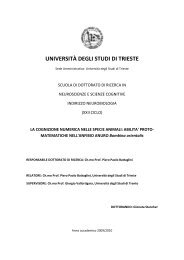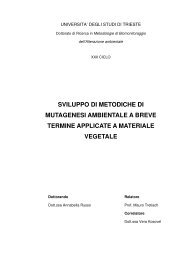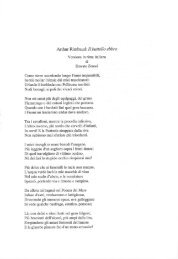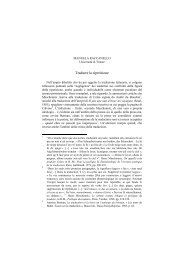Melchiorre Cesarotti e le trasformazioni del paesaggio ... - OpenstarTs
Melchiorre Cesarotti e le trasformazioni del paesaggio ... - OpenstarTs
Melchiorre Cesarotti e le trasformazioni del paesaggio ... - OpenstarTs
Create successful ePaper yourself
Turn your PDF publications into a flip-book with our unique Google optimized e-Paper software.
neither to rely on the poetry of English gardening nor to invoke the enchanted palaces<br />
of Tasso. Pinali defined the ideal form that should have been invoked as «antica<br />
italiana moda ed industria felice che coll’apparenza di infingere la piu semplice<br />
natura maneggia». It sounds convincing and intelligent, but to find physical forms<br />
by which to translate it was much more of a chal<strong>le</strong>nge.<br />
These practical and physical design choices for the Giardini Pubblici were<br />
being made in the theoretical context of meditations upon giardini moderni and<br />
giardini italiani that had first been presented to members of the Paduan Academy<br />
of Science, Letters and Arts in 1792 by Pindemonte and four years later by Mabil,<br />
both col<strong>le</strong>cted in 1817 along with other contributions into a publication entit<strong>le</strong>d<br />
Operette di vari autori intorno ai giardini ing<strong>le</strong>si ossia moderni 30 (the indecisions of<br />
that tit<strong>le</strong> say much about the issues being confronted); 31 this col<strong>le</strong>ction was issued<br />
at exactly the time when the Venetian project for the public gardens was<br />
being executed from 1806 onwards. Additionally, there was a flood of European<br />
publications: the same year that Pindemonte spoke to the Paduan Academy an<br />
Italian translation of Abbé Delil<strong>le</strong>’s poem on gardens was published, in which<br />
among other aphorisms he opined that he did not see any need to choose between<br />
French and English sty<strong>le</strong>s («Je ne decide point entre Kent et Le Notre»);<br />
Erco<strong>le</strong> Silva’s Dell’Arte de’ Giradini saw two editions in 1801 and 1813, a work that<br />
(as had Mabil’s) drew copiously upon Hirschfeld’s Theorie der Gardenkunst, a massive<br />
German treatise that applied itself very carefully, if ec<strong>le</strong>ctically, to drawing<br />
out modern and local raisons d’etre for national public gardens. Even a major pattern<br />
book of many varieties of design items, mainly of picturesque scope, by<br />
Grohmann was issued in Venice in 1805 presso Giuseppe Romondini. 32 To sett<strong>le</strong><br />
adequately and convincingly upon a garden sty<strong>le</strong> that did indeed present a local<br />
and vital «maniera di vivere e di pensare» in the midst of this substantial and<br />
wide-ranging debate was difficult. Various designers after Selva during the 19 th<br />
century strugg<strong>le</strong>d to reconci<strong>le</strong> these various demands upon a new urban park,<br />
which could characterize itself as a ‘garden’, was truly modern and at the same<br />
time was aptly Venetian, which is to say (as Selva himself realized) that it was<br />
not a mainland city: 33 all they did was to play around with a mixture of regular<br />
or irregular forms In short, what had begun to be debated in Italy around and<br />
in the years after 1800, in respect of the various landscapes of wild, solitary and<br />
communal or social, continued to be in question. Nor has that debate gone away<br />
today – but that is another story.<br />
30 Operette di varj autori intorno ai giardini ing<strong>le</strong>si ossia moderni, Verona, Mainardi, 1817 (reprint<br />
Trieste, 2010).<br />
31 Both Walpo<strong>le</strong> and Whately saw the English landscape garden as essentially modern. Whi<strong>le</strong><br />
Manetti designed in both ‘modern’ and ‘pittoresco’ sty<strong>le</strong>s for the gardens of the Villa Poggio<br />
Imperia<strong>le</strong>, in Florence: see The Picturesque Garden in Europe (note 22 above), p. 192 and figure 179.<br />
32 L’Arte dei Giardini. Scritti teorici e pratici dal XIV al XIX secolo, cit. (see note 20), II. p. 37.<br />
33 See Figures VII. 16-19 in my book, The Venetian City Garden (note 27 above).<br />
transformations in landscape circa 1800.<br />
17


